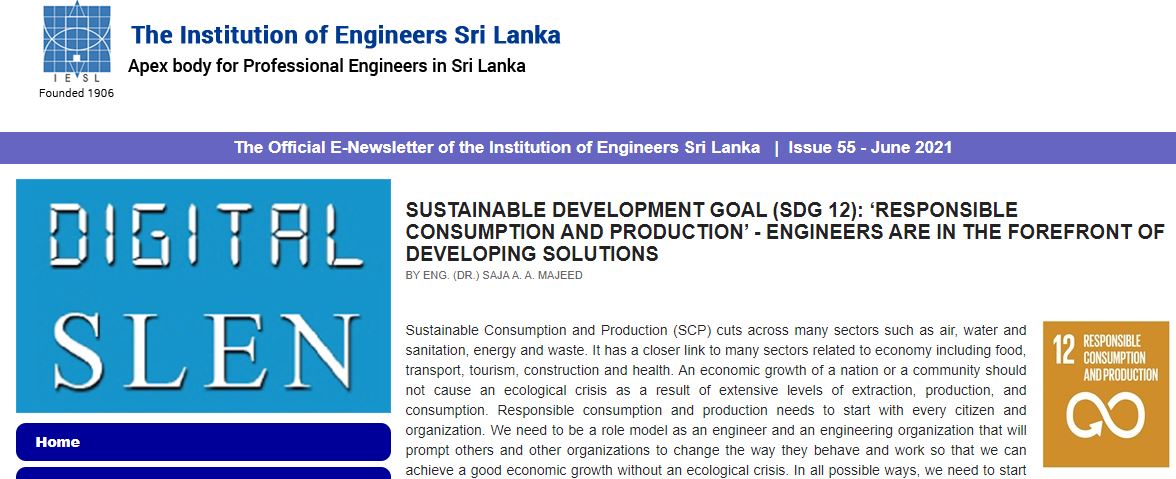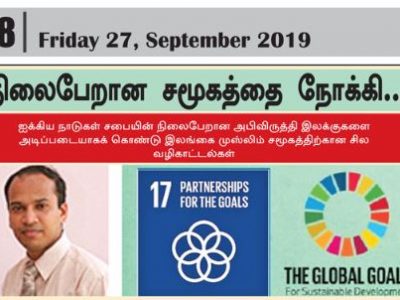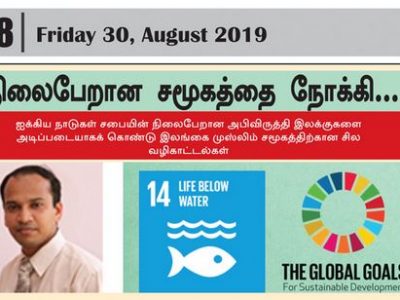Future of coastal cities in the Eastern Province of Sri Lanka-13 Years after 2004 Tsunami
Aslam Saja (The Island 26th December 2017)
Tsunami disaster 2004
Sri Lanka was hit by an Indian Ocean Tsunami on 26, December 2004. It was recorded as one of the worst disasters ever in the history of Sri Lanka due to enormous loss of lives, damages to infrastructure and economy of the coastal regions of Sri Lanka. 75% of the Sri Lankan coastal region was impacted by this tragedy which left many homeless and severe disruption to their livelihood. The youth in the twenty first generation listen to the stories of 1957 floods and 1978 cyclone in the Eastern coast of Sri Lanka from our ancestors, until the 2004 Tsunami was written in the historical timeline of disaster events. The history recorded a previous tsunami in 1883 that propagated across the Indian Ocean due to the destruction of Kraktoa’s mountain peak.
Are we prepared to face another Tsunami?
Prevention, Mitigation and Preparedness to disasters start with information. It has been proven in many cases that where information was adequately transmitted through a range of different techniques to the communities at risk, i.e., vulnerable people, people were able to act on time to avoid considerable damages to life and their livelihoods. This wasn’t the case in 2004 Tsunami due to lack of knowledge and experience of such a large scale Tsunami events in the past history of Sri Lanka. Disaster risk reduction and resilience are not simply a matter of sophisticated technology and hardware, at root it is also a matter of people, their vigilance, communication, and education. Even after 13 years, the experiences and memories of Tsunami are still not faded from people. It is evident from very recent chaos in the Eastern coastal areas of a Tsunami rumour, when people observed abnormalities in the sea. People were very fast to act and be prepared to evacuate even without an early warning from the authorities. An excessive fear of Tsunami shows the extent of the tragedy that left in peoples’ mind, despite the fact that there was no scientific evidence and warning of Tsunami from responsible authorities during the recent chaos due to rumour. However, the question still remains unanswered perhaps difficult, to be confident that, our coastal cities are safer and resilient to face disasters and emerging social challenges? A study done by Arup International identified 12 key themes for a resilient city: essential needs; health management; livelihood support; law enforcement; social harmonisation; information and knowledge management; capacity and coordination; critical infrastructure management; environmental management; urban strategy and planning; economic sustainability; accessibility. It is right time to reflect our coastal city plans, particularly the coastal cities in the Eastern Province whether they have minimum standards for a resilient city.
Beyond Tsunami resilient cities – Is the city Green, Safer, Sustainable, and Resilient (GSSR)?
It is estimated that 44% of the population living in urban areas in Sri Lanka (IPS 2012) and 50% of the Sri Lankan population will be living in urban localities by 2020 due to rapid annual urban growth, which is 3% as well as transformation of rural areas to urban. Further, around 70% of the urban population and 80% of national economic infrastructure is concentrated in coastal and mountain cities. Most of the coastal and mountain cities of Sri Lanka are highly vulnerable to multiple hazards. Coastal cities are at higher risk for sea level rise, salination of water resources, and storm surges that impact human settlements, city productivity and service delivery (UNHABITAT 2014).
Almost all the coastal regions of North and Eastern Parts of Sri Lanka were badly damaged by 2004 Tsunami disaster. Many development initiatives had taken place in the Post-Tsunami phase and in the post-war period since 2009. However, are we building a Green, Safer, Sustainable, and Resilient (GSSR) coastal cities, that is not only vulnerable to Tsunami hazard, but to multiple natural hazards such as cyclone and flooding, and to other social shocks, is the key question to ask ourselves. Due to higher population density in many of the coastal cities in the Eastern Province, it is not only to think about disaster resilient coastal cities, but a safer city from social crimes and a greener and sustainable city to combat against the climate and health risks.
Urban planning and liveable cities
A more holistic approach is required to design, plan, and manage a Green, Safer, Sustainable, and Resilient (GSSR) dynamic coastal city by integrating effective economic, social, and environmental processes as well as their physical elements. Finally, it boils down to visionary political leadership and local governance. Is it simply a question of political vision? Of course, Yes. I happen to come across a good example of a planned city in India – Chandigarh. Chandigarh was described as a dream city of India’s first Prime Minister, Jawahar Lal Nehru. The master plan of the city was prepared by Swiss-French architect Le Corbusier and in 2016, Chandigarh’s Capitol Complex was declared by UNESCO as the latest addition to World Heritage. The city is known for its best architecture, modernisation, and urban design. Sri Lankan coastal cities need to get a new gesture, new dimension, and new inspiration.
The Institute of Policy Studies (IPS) proposed a new definition for urban areas. A GN division is defined as an urban area if a GN division has a minimum population of 750 persons, a population density greater than 500 persons per square kilometres, firewood dependence of less than 95 % households, and well-water dependence of less than 95% households (IPS 2016). Eight coastal districts are among the top ten list of highest urban population in Sri Lanka (See Figure 2). Given this context and definition for urban areas, are the urban cities liveable and will we have a breathable and safer space for our future generation?
Many factors influence in determining a liveable city. It was reported by Economist Intelligent Unit that the Melbourne city holds onto first place for the seventh year in a row, among 140 cities around the world. The rating was done based on many indicators on five broad categories: stability; healthcare; culture and environment; education; and infrastructure. For example, stability factor includes the indicators of prevalence of social crimes and threat to violence/conflict; healthcare includes the availability and quality of public and private healthcare; cultural/environmental indicators include the sporting/cultural availability, level of corruption, and social/religious/cultural restrictions; education indicators include availability, access, and quality of public and private education; the infrastructure indicators such as quality of road network, public transport, housing, energy provision, water provision, and quality of telecommunication. I don’t aim to compare the liveability index of the cities in developed countries, but at minimum we aim to reach the minimum standards of living. The population density of few major cities is more than ten to twenty times fold than an average population density of a local authority in Sri Lanka. Most of our cities in the Eastern province suffer from lack of identity of its own, and lost in taking a shape for a liveable city. In this context, it is imperative that our cities are developed with proper urban design and modern transformations.
Development of cities and politics in the Eastern Province
A five year Eastern Development Plan (2012-2016) produced by Eastern Provincial Council road map for the development activities and to provide solutions to address the challenges. The plan outlines many sectoral plans that includes agriculture, forestry, land, livestock, and fisheries, housing and infrastructure development, Industrial, and Human development. Among many initiatives to develop and transform villages and cities to the modern state of the art, many local authorities have failed in the Eastern province to find solutions to the most pressing social, economic, and environmental issues.
For example, due to lack of development along with the increasing population and their needs within the Kalmunai Municipality for the past three decades, people from Sainthmaruthu have been demanding for a separate local authority. The failure of political leadership to keep a pace to the development needs of the people has intensified recently and the Kalmunai Municipality is at the verge of complete debacle, which limits its ability to further advance its development. The upcoming local government elections will reflect the ongoing turmoil, where Sainthamaruthu division, which is homed to 30% of the total voters/population of the Kalmunai Municipality has taken a decision to field candidates in an independent group in support of their demand for separate local authority. The changing political landscape not only in Kalmunai Municipality, but in many of the local authorities in the Eastern Province is yet to be seen, however undoubtedly a change in political authority is highly likely. In the midst of poor local leadership, stunted development with a long-term goals, and lack of understanding of the civic responsibility further accrued to the worst situation during the past eight years since the end of the war in 2009. The political leadership completely failed to understand the needs of the people and continued to divide the people, aggravating regionalism and ethno-centric politics, resulted in unrealistic promises that could not be met by the current political leaders. People upraise in a series of protests and demonstrations with the help of social media, viewed as similar to the uprisings held in middle-east countries to gain their demands and continuous betrayal of current local and national political leaders. The time has come to change the political culture and the layout in which politics is centred on peoples’ needs and rights, devoid the ethos of using people as shield to the benefit of corrupted and reckless political clan. People need to be more educated and aware to exercise their votes in the upcoming local government elections to save their cities from another political Tsunami, and further to survive in any future Indian Ocean Tsunami that is not of our wish.
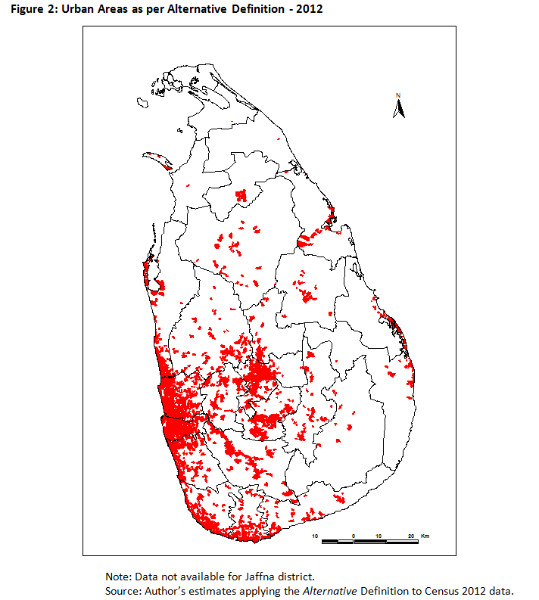
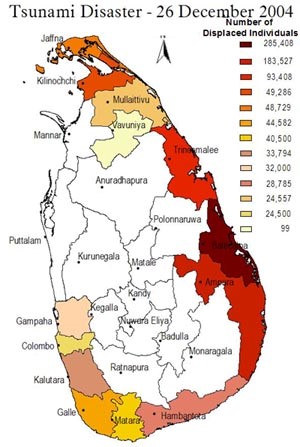
(Writer is a Lecturer, Faculty of Engineering, South Eastern University of Sri Lanka, Oluvil and currently a PhD Scholar on Disaster Resilience, saja.aslam@gmail.com)

